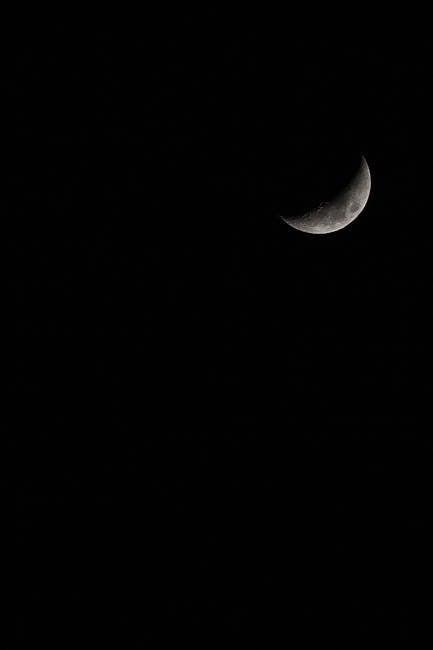The Moonlight screenplay, written by Barry Jenkins and Tarell Alvin McCraney, is a poignant exploration of identity, masculinity, and belonging. This seminal work in contemporary cinema is widely available as a PDF, offering insights into its structured narrative and emotional depth, making it a powerful example of modern storytelling.
1.1 Overview of the Screenplay’s Significance
The Moonlight screenplay, adapted from Tarell Alvin McCraney’s play, is a landmark work in contemporary cinema. Its exploration of identity, masculinity, and belonging resonated deeply, earning it the Academy Award for Best Adapted Screenplay. The script’s structured narrative, divided into three acts, offers a profound look at Chiron’s journey, making it a vital study for filmmakers and writers. Its availability as a PDF has further cemented its influence and educational value.
1.2 Historical Context and Background
Moonlight is adapted from Tarell Alvin McCraney’s unpublished play, In Moonlight Black Boys Look Blue, drawing from his semi-autobiographical experiences. The screenplay, co-written with Barry Jenkins, reflects the cultural and social challenges faced by African-American communities, particularly in Miami. Its exploration of identity, sexuality, and masculinity resonates deeply, making it a groundbreaking work in contemporary cinema. The PDF version of the screenplay has become a vital resource for studying its nuanced storytelling and historical relevance.

The Writers Behind Moonlight
Barry Jenkins and Tarell Alvin McCraney co-wrote the acclaimed screenplay, blending their unique perspectives to craft a powerful story that earned numerous awards, including the Academy Award for Best Adapted Screenplay.
2.1 Barry Jenkins: Director and Co-Writer
Barry Jenkins, a visionary filmmaker, co-wrote and directed Moonlight, earning widespread acclaim. His adaptation of Tarell Alvin McCraney’s play captured the essence of identity and vulnerability, leading to historic Oscar wins. Jenkins’ nuanced storytelling and emotional depth resonated globally, making the Moonlight screenplay PDF a sought-after resource for filmmakers and writers. His work continues to inspire, showcasing his mastery of cinematic storytelling and adaptation.
2.2 Tarell Alvin McCraney: Playwright and Co-Writer
Tarell Alvin McCraney, a celebrated playwright, co-wrote Moonlight with Barry Jenkins, adapting his semi-autobiographical work In Moonlight Black Boys Look Blue. His contribution brought raw emotional depth and authenticity to the screenplay, exploring themes of identity and vulnerability. McCraney’s collaboration was pivotal in shaping Chiron’s journey, making the Moonlight screenplay PDF a testament to his storytelling genius and the film’s cultural impact.
2.3 Collaboration and Creative Process
Barry Jenkins and Tarell Alvin McCraney’s collaboration on Moonlight was a harmonious blend of their unique perspectives. Jenkins adapted McCraney’s unpublished play, In Moonlight Black Boys Look Blue, infusing it with cinematic depth. Their shared vision created a screenplay that resonated deeply, earning widespread acclaim. The Moonlight screenplay PDF highlights their collaborative genius, offering insights into the emotional and narrative craftsmanship that defined the film’s success.

Structure of the Moonlight Screenplay
The Moonlight screenplay PDF reveals a three-act structure, each focusing on a different phase of Chiron’s life. This tripartite narrative design allows for a deep exploration of his identity and growth, with each act building on the previous to create a cohesive and emotionally resonant story.
3.1 Three-Act Structure: Chiron’s Journey
The Moonlight screenplay PDF is structured into three acts, each capturing a pivotal phase of Chiron’s life. Act I introduces him as “Little,” a vulnerable child navigating bullying and mentorship. Act II follows “Chiron,” a teenager grappling with identity and first love. Act III presents “Black,” a hardened adult revisiting his past. This tripartite design masterfully explores themes of identity, masculinity, and belonging, with each act building on the previous to create a profound narrative arc.
3.2 Narrative Design and Pacing
The Moonlight screenplay PDF employs a non-linear narrative design, blending visual and symbolic storytelling. The pacing is deliberate, with moments of silence and subtlety that amplify emotional depth. Jenkins uses a muted color palette and strategic lighting to enhance the tone, while the script’s structure balances introspective character development with dramatic tension, creating a lyrical and immersive experience that mirrors Chiron’s internal journey and emotional evolution.

Themes Explored in Moonlight
The Moonlight screenplay PDF delves into themes of identity, self-discovery, and masculinity, exploring Chiron’s journey through vulnerability, love, and the quest for belonging in a challenging world.
4.1 Identity and Self-Discovery
The Moonlight screenplay PDF profoundly explores Chiron’s journey of identity and self-discovery, depicting his struggle to reconcile his sexuality and sense of belonging. Through three acts, the narrative captures his transformation from vulnerability to self-acceptance, highlighting the societal pressures and personal introspection that shape his understanding of self. The screenplay’s nuanced portrayal of Chiron’s internal conflict underscores the universal quest for identity, making it a deeply resonant and human story.
4.2 Masculinity and Vulnerability
The Moonlight screenplay PDF delves into the tension between traditional masculinity and vulnerability, particularly through Chiron’s journey. The narrative challenges societal expectations of male strength, portraying Chiron’s internal struggles and emotional depth. Scenes like the beach encounter with Kevin highlight the fragility of masculinity, offering a nuanced exploration of how vulnerability can coexist with strength. This theme resonates deeply, questioning rigid gender norms and celebrating emotional authenticity.
4.3 Love and Belonging
The Moonlight screenplay PDF poignantly explores themes of love and belonging through Chiron’s relationships. His bond with Juan and Kevin offers moments of tenderness, contrasting with his isolating environment. The screenplay highlights the struggle to find acceptance and connection, emphasizing how love can transcend adversity. These interactions underscore Chiron’s quest for identity and the universal human need for belonging, making the narrative deeply resonant and emotionally profound.

Symbolism and Motifs
The Moonlight screenplay PDF employs powerful symbols like water, representing purification and transformation, and color, enhancing emotional depth, to convey Chiron’s journey and inner struggles effectively.
5.1 The Recurring Motif of Water
Water in the Moonlight screenplay PDF symbolizes purification, transformation, and emotional depth. It appears in pivotal scenes, such as Chiron’s beach encounters, reflecting his inner journey and self-discovery. The motif underscores themes of cleansing and renewal, mirroring Chiron’s struggle to navigate his identity and find acceptance in a hostile world. This symbolic element enhances the narrative’s emotional resonance, making it a powerful storytelling device in the film.
5.2 Use of Color and Lighting
The Moonlight screenplay PDF employs color and lighting to evoke emotional depth and thematic resonance. Cool tones dominate scenes of isolation, while warm hues highlight moments of connection and vulnerability. Lighting is used strategically to reflect Chiron’s internal state, creating a visual language that complements the narrative’s exploration of identity and belonging. This deliberate use of color and light enhances the film’s emotional impact and underscores its poignant storytelling.

Availability of the Moonlight Screenplay PDF
The Moonlight screenplay PDF is widely available for free download online, offering easy access to Barry Jenkins’ award-winning adaptation. Its availability has made it a valuable resource for filmmakers and writers worldwide.
6.1 Where to Download the PDF
The Moonlight screenplay PDF is accessible through various online platforms. Websites like Scrite.io, Script Slug, and The Blk Script offer free downloads. Additionally, it can be found on A24’s official website and other screenwriting repositories. These sources provide easy access to the award-winning script, allowing filmmakers and writers to study its structure and narrative depth.
6.2 Legal and Ethical Considerations
Downloading the Moonlight screenplay PDF should be done through legal and ethical channels. The script is copyrighted, and unauthorized distribution or downloading from unverified sources may infringe on intellectual property rights. Always access the screenplay from reputable websites or official sources to ensure compliance with copyright laws and support the creators’ rights. This approach respects the work of Barry Jenkins and Tarell Alvin McCraney while promoting ethical consumption of artistic content.
Awards and Accolades
Moonlight won the Academy Award for Best Picture and Best Adapted Screenplay, along with the Writers Guild Award for Best Original Screenplay. These accolades highlight its artistic and emotional depth.
7.1 Academy Awards: Best Picture and Best Adapted Screenplay
Moonlight made history by winning the Academy Award for Best Picture and Best Adapted Screenplay in 2017. Barry Jenkins and Tarell Alvin McCraney were honored for their poignant adaptation, which explores themes of identity, masculinity, and belonging. The film’s victory marked a cultural milestone, celebrating underrepresented stories. The screenplay’s structured narrative and emotional depth were widely praised, solidifying its place in cinematic history.
7.2 Other Notable Awards and Nominations
Beyond the Oscars, Moonlight received widespread acclaim, earning the Writers Guild Award for Best Original Screenplay and the Scripter Literary Achievement Award. It also won the Gotham Independent Film Award for Best Feature and was nominated for four Golden Globes. These recognitions underscored the screenplay’s artistic and cultural impact, further cementing its legacy as a landmark work in contemporary cinema and a vital resource for film studies and screenwriting education.

Impact and Legacy
Moonlight has profoundly influenced contemporary cinema, inspiring filmmakers and sparking conversations on representation. Its screenplay is widely studied in film schools, leaving a lasting cultural imprint.
8.1 Cultural Significance and Representation
Moonlight holds profound cultural significance, offering an authentic portrayal of African-American experiences, masculinity, and sexuality. Its Oscar win marked a historic milestone, being the first film with an all-black cast to win Best Picture. The screenplay’s availability as a PDF has enabled widespread educational use, inspiring filmmakers and fostering dialogue on representation, while challenging stereotypes and broadening cinematic narratives.
8.2 Influence on Future Filmmaking
Moonlight has reshaped contemporary cinema, inspiring filmmakers to explore nuanced storytelling and diverse narratives. Its success with a small budget and non-traditional structure has encouraged indie filmmakers to experiment. The screenplay’s availability as a PDF has made it a study tool, influencing emerging writers to focus on authenticity and emotional depth, while paving the way for more inclusive and innovative storytelling in the film industry.

Analysis of Key Scenes
The screenplay’s pivotal moments, like Chiron’s hiding in the crack house and his beach encounter with Kevin, masterfully convey emotional depth and character transformation through subtle dialogue and vivid descriptions.
9.1 The Opening Scene: Setting the Tone
The screenplay opens with Little hiding in a crack house, introducing themes of vulnerability and escape. Juan’s kindness contrasts with the harsh environment, setting a tone of tension and hope. The scene’s dialogue and descriptions, such as the rundown apartment complex, establish the film’s emotional landscape and Chiron’s fragile world, drawing viewers into his journey of self-discovery and resilience.
9.2 The Beach Scene: A Pivotal Moment
The beach scene marks a turning point in Chiron’s journey, where he opens up to Kevin about his struggles. The dialogue is sparse yet profound, capturing Chiron’s vulnerability. The setting, with its soft lighting and calming waves, contrasts with the harshness of his daily life, creating a moment of raw emotional connection. This scene, detailed in the screenplay, underscores the power of human intimacy and its lasting impact on Chiron’s identity.
Adaptation from the Original Play
Moonlight is adapted from Tarell Alvin McCraney’s unpublished play In Moonlight Black Boys Look Blue. Barry Jenkins transformed the semi-autobiographical story into a cinematic masterpiece, earning acclaim for its faithful yet innovative adaptation, as detailed in the screenplay PDF.
10.1 From “In Moonlight Black Boys Look Blue” to Screen
Tarell Alvin McCraney’s unpublished play, In Moonlight Black Boys Look Blue, inspired Barry Jenkins to craft the Moonlight screenplay. The adaptation retained the original’s emotional depth and themes of identity, while expanding its cinematic scope. The screenplay PDF includes a foreword by Frank Ocean and an essay by Hilton Als, offering insights into the adaptation process and its cultural significance. This collaboration between Jenkins and McCraney resulted in a film that transcended its theatrical roots, becoming a landmark of contemporary cinema.
10.2 Changes and Enhancements in the Screenplay
The screenplay expanded on Tarell Alvin McCraney’s original play, enhancing its visual and emotional depth. The tripartite structure was refined, with vivid descriptions and dialogue that captured Chiron’s internal struggles. Symbolic elements, like water motifs, were emphasized, and the use of color palettes added layers of meaning. The PDF version includes a foreword by Frank Ocean, enriching the narrative’s context and highlighting the film’s cultural impact. These enhancements elevated the story’s universality and artistry.

Screenplay Format and Style
The Moonlight screenplay features a unique format with vivid descriptions and sparse dialogue, enhancing its visual storytelling. The use of color palettes and emotional language adds depth to the narrative.
11.1 Unique Formatting Choices
The Moonlight screenplay employs a distinctive three-act structure, each focusing on a different phase of Chiron’s life. The use of color palettes and lighting descriptions enhances emotional depth, while sparse dialogue allows visuals to dominate. The script’s concise yet evocative language creates a poetic tone, reflecting the protagonist’s internal journey. This format, combined with vivid imagery, underscores the film’s thematic exploration of identity and vulnerability, making it a masterclass in visual storytelling.
11.2 Dialogue and Descriptive Writing
The screenplay balances sparse, impactful dialogue with evocative descriptions, capturing raw emotion and vulnerability. Conversations are concise yet profound, reflecting characters’ inner worlds. Descriptive passages vividly paint settings and atmospheres, enhancing the emotional tone. This blend of brevity and depth creates a poetic, immersive narrative, drawing readers into Chiron’s journey and amplifying the film’s thematic resonance.

Visual Storytelling in the Screenplay
The screenplay employs vivid descriptions and symbolic imagery, such as water motifs, to visually convey Chiron’s emotional journey and transformation, enhancing the narrative’s depth and resonance.
12.1 The Role of Cinematography
The screenplay’s visual storytelling is enhanced by its cinematography, which uses color and lighting to reflect Chiron’s emotional journey. The recurring motif of water symbolizes purification and transformation, while the film’s visual style creates a hauntingly beautiful backdrop for its narrative, deeply immersing the audience in Chiron’s world and emotional struggles.
12.2 Enhancing Emotional Tone Through Description
The screenplay’s descriptive language enriches the emotional tone by painting vivid imagery that mirrors Chiron’s internal struggles. The use of color, such as blue hues symbolizing identity, and lighting that shifts between warmth and coolness, creates a visual and emotional resonance. Water motifs further deepen the narrative’s emotional layers, reflecting purification and transformation, while the text’s concise yet evocative style immerses readers in Chiron’s poignant journey of self-discovery and growth.
Critical Reception and Reviews
The Moonlight screenplay received widespread acclaim for its emotional depth and nuanced storytelling. Critics praised its structured narrative and vivid descriptions, earning it the Academy Award for Best Adapted Screenplay.
13.1 Positive Reviews and Praise
The Moonlight screenplay received widespread critical acclaim, earning the Academy Award for Best Adapted Screenplay and Best Picture. Critics praised its emotional depth, nuanced storytelling, and structured narrative. The screenplay’s vivid descriptions and poignant exploration of identity resonated deeply with audiences and scholars alike. Its availability as a PDF has made it a powerful tool for film studies, showcasing the artistry behind this modern cinematic masterpiece.
13.2 Critical Analysis and Insights
Critics have lauded the Moonlight screenplay for its nuanced portrayal of identity, masculinity, and vulnerability. The tripartite structure and symbolic motifs, such as water, enhance its emotional resonance. Analysts highlight the screenplay’s ability to balance poetic dialogue with cinematic visuals, making it a masterclass in storytelling. Its exploration of themes through subtle yet powerful narrative choices has solidified its place as a landmark in contemporary screenwriting, offering invaluable insights for filmmakers and scholars alike.
Educational Resources and Study
The Moonlight screenplay is widely used in film studies for its structured narrative and emotional depth. Available on platforms like Script Slug and Scrite, it serves as a valuable resource for aspiring screenwriters, offering insights into storytelling techniques and character development through its poignant exploration of identity and vulnerability.
14.1 Using the Screenplay in Film Studies
The Moonlight screenplay is a valuable resource in film studies, offering insights into narrative structure, character development, and thematic exploration. Its three-act design and poignant portrayal of identity, masculinity, and vulnerability provide rich material for analysis. Educators often use the PDF version to teach students about storytelling techniques, emotional depth, and the adaptation process. It serves as a powerful tool for understanding contemporary cinema and its impact on cultural narratives.
14.2 Workshops and Analysis Guides
Workshops and analysis guides for the Moonlight screenplay provide deeper insights into its narrative structure and themes. These resources, often paired with the PDF version, help filmmakers and students analyze character arcs, dialogue, and emotional depth. Guides highlight the screenplay’s unique formatting and its adaptation from the original play, offering practical lessons for aspiring writers. Such materials are invaluable for understanding the craft behind this award-winning story.


